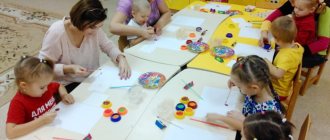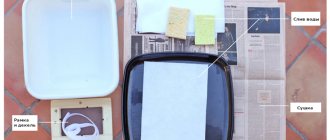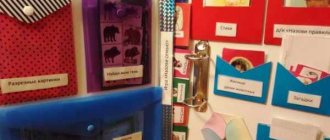History of watches for children. You can simply read a book about the history of watches to your child. You can let me watch a video. And we will explore the history of watches through entertaining stories, pictures and experiments! Indeed, for the successful development of a preschooler’s mental abilities, it is best to give him the opportunity to discover new knowledge for himself, learn to solve cognitive problems, try to ask questions and answer them. This will be very useful to him both at school and in life! I invite you on a journey into the past and future of watches!
Our history of watches is very different from the dry text of a history textbook. She is lively and surprisingly interesting, inspiring and awakening new ideas! The story of a clock for preschoolers is structured as a dialogue with a child, as a joint search between an adult and a child for answers to questions. This story is not meant for one day. It can be used on a walk and at home, in kindergarten and at a party. I wish you creative communication with your baby!
Why do you need a watch?
Why do we need a clock? What do you think would happen if no one had a watch? If it is difficult for a child to answer a question, start thinking out loud yourself - fantasize (Here is what children can answer: “Dad wouldn’t know when to go to work”, “We would go to Misha’s birthday, but wouldn’t know the time. Come - and there’s no one there anymore. And we’d be upset,” “We’d go to the toy store, but it’s closed,” “We’d be late everywhere,” “We could miss the train or plane”)
How do you think people used to live without watches? How did people determine time? (Give your child the opportunity to think, think for yourself. After all, there was a time when there were no clocks. How did people get by without them?)
It turns out that there were clocks before, but in those ancient times they were different -... alive!!! Guess what a “live clock” is? What could they be? After asking a question, always pause to think and answer. If your baby is shy or at a loss, start thinking out loud and asking yourself questions. The child will gradually listen to you and reason with you. And then he will join the discussion and express his opinion. Let the child express the most fantastic assumptions, encourage him for them - he thinks and he expresses HIS OPINION, and this is VERY VALUABLE! It is much easier to retell someone else’s opinion to a preschool child than to have your own and express it in words. And in our modern life, the ability to formulate one’s point of view is the basis for success in many matters. After your child has dreamed up his imagination, tell him about a real live clock.
Presentation for a lesson on introducing clocks to preschoolers
NINA ARAKELYAN
Presentation for a lesson on introducing clocks to preschoolers
Presentation for a lesson on introducing clocks to preschoolers
Goal: development of temporal concepts in children of senior preschool age.
Objectives: To introduce children to the history of watches.
Expand children's knowledge about different types of watches, the principle of their operation and their role in our lives.
Cultivate an interest in technology and respect for equipment.
Cultivate curiosity and respect for time.
Expand your horizons and enrich your children’s vocabulary.
CLOCK-ROOSTER (slide 2)
This clock walks importantly around the yard, flaps its wings and, flying up onto the fence, shouts “cuckoo.”
- Did you find out who it is? The sun has not yet risen, and the rooster is already crowing, scratching its throat...
Morning is coming! Enough sleep!
The peasants noticed that the rooster began to crow for the first time when the sun had not yet appeared, but had only released its first ray. It was with the first cry of the rooster that the housewives got up to milk the cows and drive them out to pasture. The cockerel also helped arrange a meeting. For example, they said this: “Tomorrow we will go to the forest to pick mushrooms and berries. And we’ll meet outside the outskirts after the third rooster.”
SUNDIAL (slide 3,4)
One day a man noticed a shadow falling on the ground from a tree. He took a closer look and noticed that the shadow did not stand still, but moved after the sun. A man watched a shadow running in a circle and came up with a clock: he dug a pillar into the ground, and around the pillar he drew a circle, dividing it into parts. Each part was equal to one hour. The sun rose and the shadow of the pillar slowly moved in a circle, marking hour after hour. They were called solar. (According to I. Melnikov).
The sundial was invented by the ancient Egyptians.
Listen to the poem:
There is also a sundial - the ancestor of all clocks!
Now they are rare.
The dial lies on the ground, but the sun runs across the sky!
They happen in squares, on the lawn, in the garden - in full view of the sun!
(Elmira Kotlyar)
But people could not always use a sundial.
– Why do you think?
– On a cloudy, rainy, gloomy day it is difficult to determine the time because there is no sun.
WATER CLOCK (slide 5,6)
And the man came up with another watch, more reliable. Water was poured into a tall glass vessel with a hole at the bottom. Drop by drop it oozed from the hole. Marks were made on the walls of the vessel, which showed how much time had passed since the moment when water was poured into the vessel. It was a water clock.
– Do you think this watch is comfortable?
“They turned out to be inconvenient because water had to be constantly added to the vessel. It is no coincidence that since then they have been saying about time: “How much water has flown under the bridge!”
HOURGLASS (slide 7.8)
People began to think about how to come up with a better clock so that it would show time equally accurately day and night, in winter and summer, and in any weather. And they came up with an idea. This watch has no hands, no circle with numbers, no gears inside. They are made of glass. Two glass vials are connected together. There is sand inside. When the clock is running, sand flows from the upper bubble into the lower one. Sand spilled out, which means a certain amount of time has passed. The clock is turned over and the counting of time continues. This clock was called an hourglass. (According to M. Ilyin, E. Segal)
And there are hourglasses - accurate!
Grains of sand flow in them - seconds fly by!
How the grains of sand gathered and settled into a mound
in a glass flask, and the minute is up!
(Elmira Kotlyar)
Hourglasses are still used in clinics and hospitals. Patients receive medical procedures using this clock, but it is impossible to find out what time it is from them.
MECHANICAL WATCH (slides 9,10,11,12)
The man thought a little more and came up with a watch that we still use today. This is a watch with a mechanism. I put a spring inside them, twisted it, and to prevent it from unwinding, I attached a gear wheel to it. It clings to another wheel and turns it. The second wheel turns the hands, and the hands show the hours and minutes. This is a mechanical watch. They have a crown. When it is turned, a creaking sound is heard inside the clock. This is the spring being wound up. To keep the clock from stopping, it must be wound constantly.
There are watches without a spring. Instead, there is a small electric motor inside the watch, which is powered by a battery. There is no need to wind such a watch. And the crown serves only to move the hands. (According to I. Melnikov)
Mechanical watches were invented in the 17th century by the scientist Christian Huygens, and since then they have served us faithfully.
CUCKOO CLOCK (slide 13)
– What kind of watch “can cuckoo”?
- Cuckoo-clock! A “cuckoo” hides in a clock made in the shape of a patterned wooden hut. Every hour the door of the house opens and the cuckoo appears on its threshold. She sings loudly: “Kuk-ku, kuk-ku,” reminding us of what time it is.
Materials for work
Clocks are made for children as educational props. Older children are able to make real specimens from scrap materials. An old clock, crafts from which will turn out to be original, will serve as a decorative element in the house. The material for the dial can be:
- cardboard;
- paper;
- disposable tableware;
- ropes;
- threads;
- pencils and markers;
- natural materials;
- fabrics;
- used CDs, other materials.
Decorating watches from plywood
There are many ways to decorate wall walkers with a plywood base. It all depends on the flight of fancy, the willingness to spend time to translate the idea into reality and the materials at your disposal.
Acrylic paints
A plywood clock will look aesthetically pleasing if painted with acrylic paint. First of all, the base needs to be prepared and primed.

This is done to ensure that cracks do not form inside the veneer due to temperature changes or high humidity. The primer ensures a tight bond between the paint and the plywood.
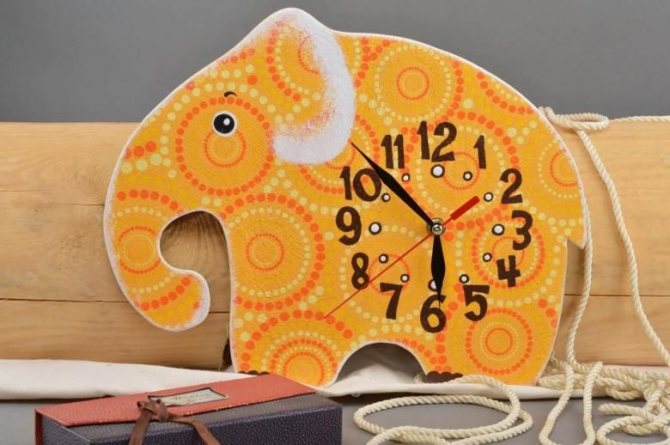
Acrylic paint for plywood crafts should be water-based. It is odorless, dries quickly and adheres well to the surface. The paint must be applied in two layers.
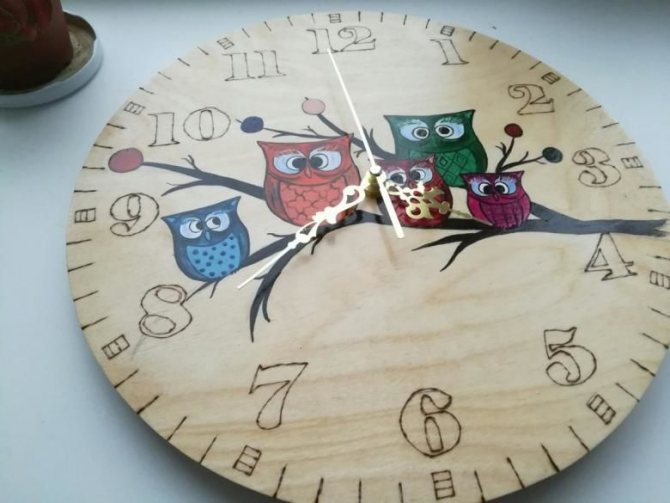
You can decorate plywood clocks with different designs. A pencil drawing is applied to the pre-primed surface, then each section of the drawing is painted in the desired color. To add gloss, acrylic varnish is applied after painting.
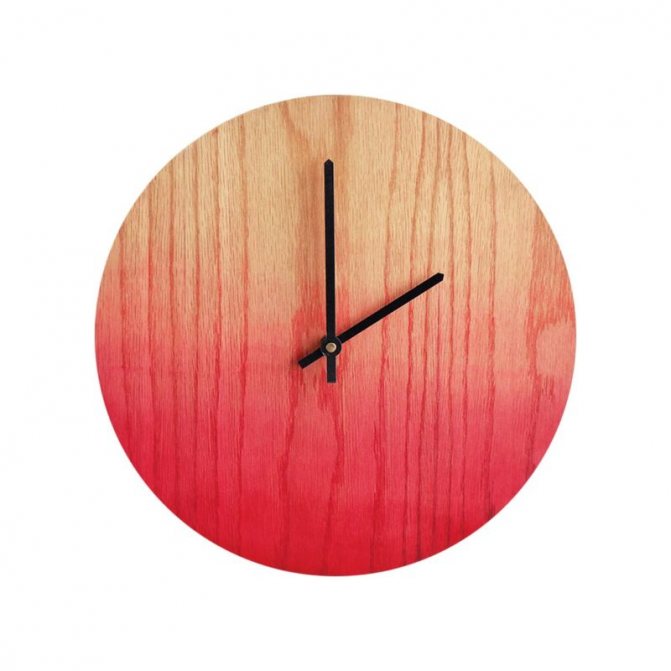
Wall clocks made of plywood can be decorated with any print that fits into the interior. A clock for a children's room can be decorated with a print of your favorite cartoon characters, for a kitchen - with pictures of vegetables and fruits, for a bedroom - with a starry sky, etc.
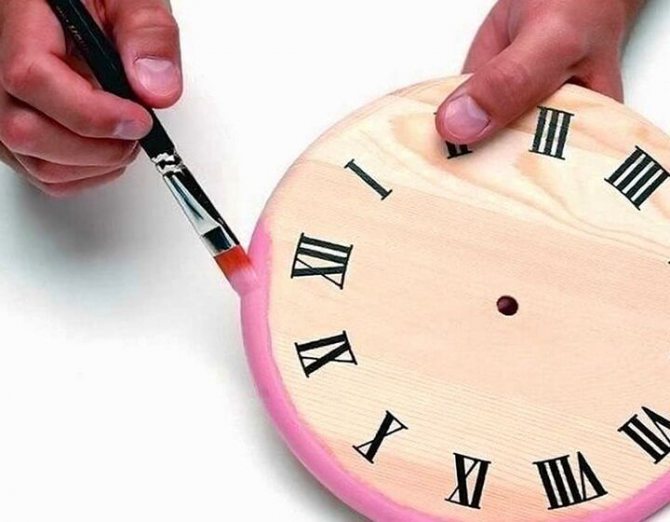
To apply a print to a watch, you need to print out the design, cut out a sheet of cardboard along the contour of the watch and stick it on the base of the watch. Then fasten the clock mechanism with the hands.
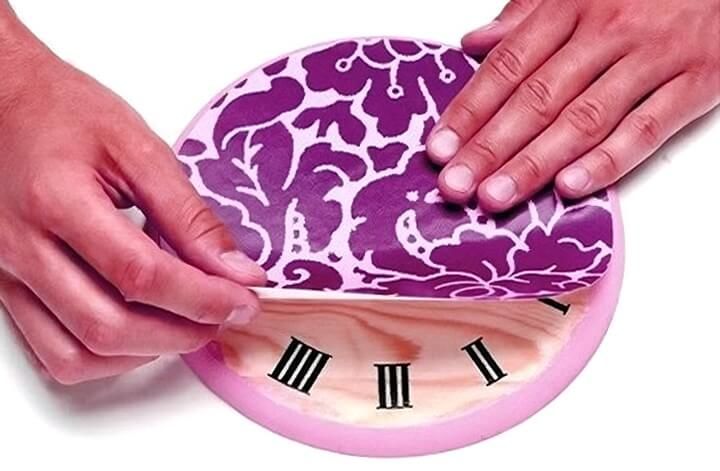
Geometric prints applied to the base of the watch, prints painted with monochromatic paints using stencils, or painted with your own hands will certainly enliven the interior.
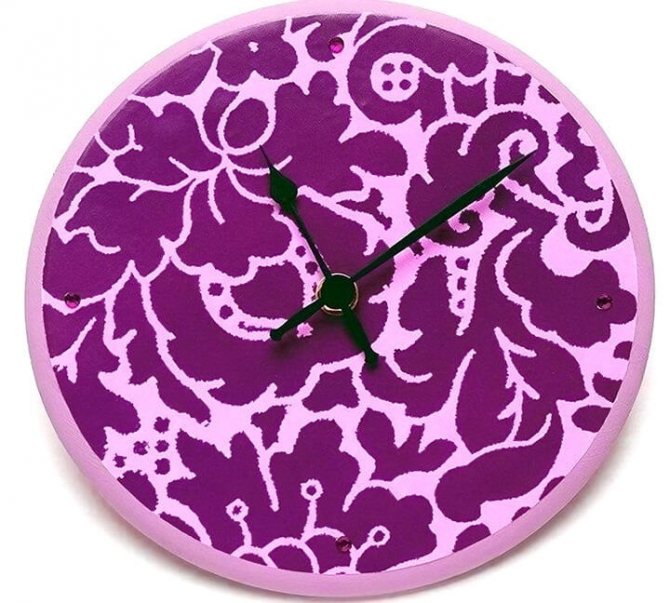
Rope
Decor made of jute or hemp rope is the hallmark of country style. The clock, made of plywood and covered around the circumference with natural jute rope, fits perfectly into an eco-style interior.
Rope is used to make not only the edging of the watch, but also the dial itself. The rope is twisted in a spiral and, using transparent “crystal” glue, is attached to the base. The rope is bleached or dyed in the desired color.
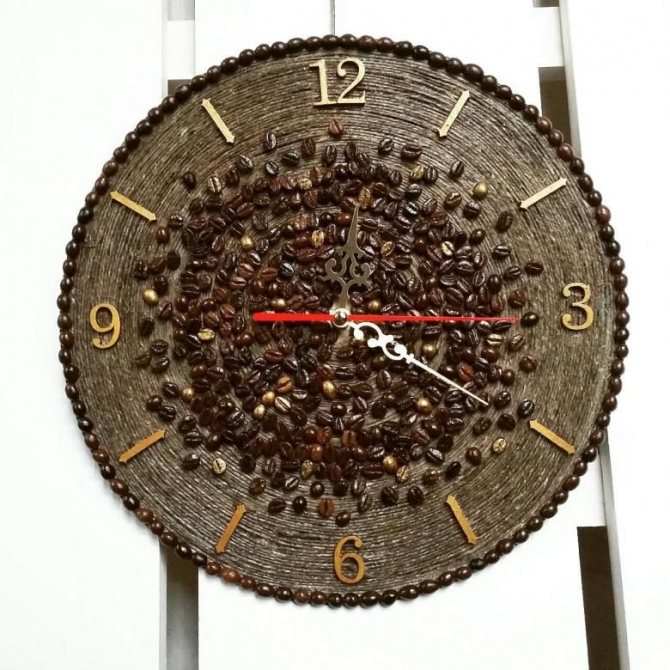
Beads
Sparkles of light and fragments of the rainbow can be created by decorating the watch with multi-colored beads. You can weave a watch frame from large wooden beads strung on wire:
- From beads of different texture, color and size, you can make rays around the base or fill the base with them. You can glue them using a glue gun.
- The beads can be arranged in a chaotic manner or filled with them into a pre-drawn outline of a design, such as a heart or a flower.
- There is nothing difficult in making watches, you just need to acquire the necessary materials in advance.
- A handmade watch will add a unique flavor and complement the interior of your home.
- And even if the craft does not even show the exact time, warmth will still emanate from it, because soul and love are put into its creation.
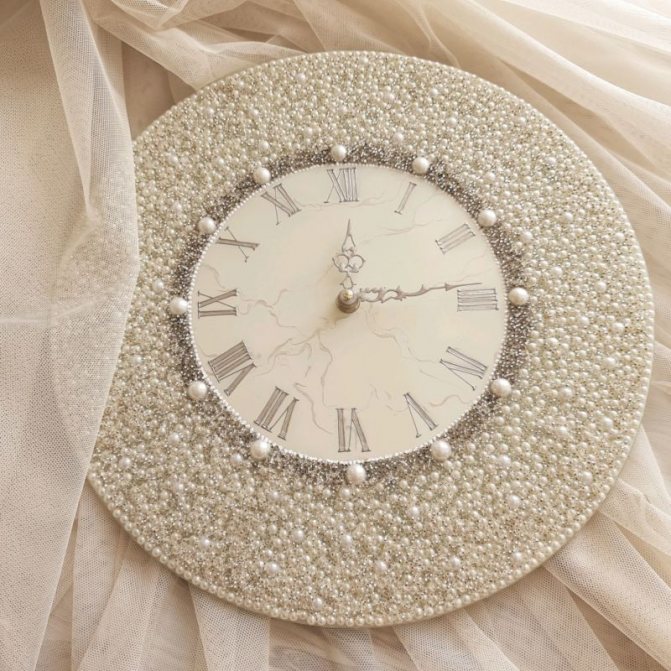
If you take the matter seriously, making homemade watches can be turned into a promising and profitable business.

